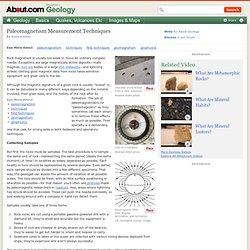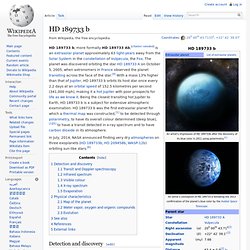

This is the most detailed map yet of our place in the universe. Myndi ekki afþakka boð út í geim. „Það var frábær viðurkenning og mikil hvatning,“ segir Kári þegar blaðamaður Fréttablaðsins nær af honum tali þar sem hann situr að störfum í Háskóla Íslands.

Measuring Paleomagnetism. Rock magnetism is usually too weak to move an ordinary compass needle.

Exceptions are large magnetically active deposits—mafic magmas, iron ore bodies or a large iron meteorite—and lightning strikes. Getting good magnetic data from rocks takes sensitive equipment and great care in the lab. Although the magnetic signature of a given rock is usually "locked" in, it can be disturbed in many different ways depending on the mineral involved, their grain sizes, and the history of the rock after its formation. The job of paleomagneticians (or "paleomagicians" as they sometimes call each other) is to remove these effects as much as possible. Their specialty is a demanding one that calls for strong skills in both fieldwork and laboratory techniques. Collecting Samples.
Magnetometer. Helium Vector Magnetometer (HVM) of the Pioneer 10 and 11 spacecraft Magnetometers are measurement instruments used for two general purposes: to measure the magnetization of a magnetic material like a ferromagnet, or to measure the strength and, in some cases, the direction of the magnetic field at a point in space.

The first magnetometer was invented by Carl Friedrich Gauss in 1833 and notable developments in the 19th century included the Hall Effect which is still widely used. Magnetometers are widely used for measuring the Earth's magnetic field and in geophysical surveys to detect magnetic anomalies of various types. They are also used militarily to detect submarines. Consequently some countries, such as the USA, Canada and Australia classify the more sensitive magnetometers as military technology, and control their distribution.
Introduction[edit] Magnetic fields[edit] HD 209458 b. HD 209458 b represents a number of milestones in extraplanetary research.

It was the first of many categories: a transiting extrasolar planet discovered, the first planet detected through more than one method, an extrasolar planet known to have an atmosphere, an extrasolar planet observed to have an evaporating hydrogen atmosphere, an extrasolar planet found to have an atmosphere containing oxygen and carbon, one of the first two extrasolar planets to be directly observed spectroscopically and the first extrasolar gas giant to have its superstorm measured, and the first planet to have its orbital speed measured, determining its mass directly.[2] Based on the application of new, theoretical models, as of April 2007, it is alleged to be the first extrasolar planet found to have water vapor in its atmosphere.[3][4][5][6] Detection and discovery[edit] Transits[edit] Spectroscopic[edit] Direct detection[edit]
Stop Using Quantum Mechanics as Evidence for Magic. MEART: The Semi-Living Artist. HD 189733 b. HD 189733 b, more formally HD 189733 Ab,[citation needed] is an extrasolar planet approximately 63 light-years away from the Solar System in the constellation of Vulpecula, the Fox.

The planet was discovered orbiting the star HD 189733 A on October 5, 2005, when astronomers in France observed the planet transiting across the face of the star.[4] With a mass 13% higher than that of Jupiter, HD 189733 b orbits its host star once every 2.2 days at an orbital speed of 152.5 kilometres per second (341,000 mph), making it a hot Jupiter with poor prospects for life as we know it. Being the closest transiting hot Jupiter to Earth, HD 189733 b is a subject for extensive atmospheric examination. HD 189733 b was the first extrasolar planet for which a thermal map was constructed,[1] to be detected through polarimetry, to have its overall colour determined (deep blue),[1][5] to have a transit detected in x-ray spectrum and to have carbon dioxide in its atmosphere.
Detection and discovery[edit] Man shrooms at Comic-Con, texts existential crisis to his girlfriend. In News by Alex MooreJul 29, 2014 8.4k t Man shrooms at Comic-Con, texts existential crisis to his girlfriend In News by Alex Moore Jul 29, 2014 A man who has identified himself as Anwar Newton decided to take shrooms at San Diego Comic-Con last weekend.

I guess images of war are never the best frame of mind to bring to any shroom trip. Young Stars Emerge from Orion's Head. Picture Album. Mars Images. Theory of everything. A theory of everything (ToE) or final theory, ultimate theory, or master theory is a hypothetical single, all-encompassing, coherent theoretical framework of physics that fully explains and links together all physical aspects of the universe.[1]:6 Finding a ToE is one of the major unsolved problems in physics.

Over the past few centuries, two theoretical frameworks have been developed that, as a whole, most closely resemble a ToE. The two theories upon which all modern physics rests are general relativity (GR) and quantum field theory (QFT). GR is a theoretical framework that only focuses on the force of gravity for understanding the universe in regions of both large-scale and high-mass: stars, galaxies, clusters of galaxies, etc. On the other hand, QFT is a theoretical framework that only focuses on three non-gravitational forces for understanding the universe in regions of both small scale and low mass: sub-atomic particles, atoms, molecules, etc. UCS Satellite Database.
Hypothetical types of biochemistry. Hypothetical types of biochemistry are forms of biochemistry speculated to be scientifically viable but not proven to exist at this time.

While the kinds of living beings currently known on Earth commonly use carbon for basic structural and metabolic functions, water as a solvent and DNA or RNA to define and control their form, it may be possible that undiscovered life-forms could exist that differ radically in their basic structures and biochemistry from that known to science. Shadow biosphere. A shadow biosphere is a hypothetical microbial biosphere of Earth that uses radically different biochemical and molecular processes than currently known life.

Although life on Earth is relatively well-studied, the shadow biosphere may still remain unnoticed because the exploration of the microbial world targets primarily the biochemistry of the macro-organisms. The term was coined by Carol Cleland and Shelley Copley in 2005.[1] 2014 July 25 - Cosmic Crab Nebula. Discover the cosmos!

Each day a different image or photograph of our fascinating universe is featured, along with a brief explanation written by a professional astronomer. 2014 July 25 Cosmic Crab Nebula Image Credit: NASA, Chandra X-ray Observatory, SAO, DSS.